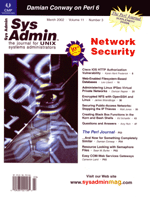Other Cisco IOS Vulnerabilities
In addition to the Cisco IOS HTTP Authorization Vulnerability,
several other security-related vulnerabilities have been discovered
in recent IOS versions. Here are brief descriptions of a few of
those vulnerabilities, along with how each one can be eliminated.
Notice that most of these vulnerabilities would not be present in
an environment where strong IOS security measures are in place.
- Three different SSH vulnerabilities were announced in a single
advisory. The most severe of the three could permit SSH sessions
to be decrypted. The only reasonable option for eliminating this
vulnerability is to upgrade IOS to a non-vulnerable version. An
alternative option is to disable SSH access, but this will likely
introduce more serious security problems by forcing administrators
to use telnet and other cleartext connection methods, so it should
only be done as a last resort if it's simply not possible
to immediately update the IOS.
- An attacker can crash a device that has the Point-to-Point
Tunneling Protocol (PPTP) enabled by sending an abnormal PPTP
packet to it. Similar to the SSH vulnerability, the options in
this case are to disable PPTP or to upgrade the IOS version. Of
course, if the device does not need to be running PPTP, it should
have already been disabled.
- One IOS vulnerability only affected the Cisco 6400 Access Concentrator
Node Route Processor 2 (NRP2). If a VTY did not have a password
set, anyone could access it via telnet. As with the other vulnerabilities,
it can be eliminated by upgrading the IOS to a non-vulnerable
version. The quick fix is to set passwords for each VTY. As mentioned
earlier, you should either have authentication properly configured
for a VTY or disable interactive logins on it.
- Certain IOS versions do not properly handle connection attempts
to certain TCP port numbers. After such an attempt, the router
will reload the next time that its configuration information is
accessed. The port numbers related to this vulnerability are unused
by IOS, so there shouldn't be any legitimate attempts to
contact them. Of course, upgrading to a non-vulnerable IOS version
will eliminate the vulnerability; also, implementing firewall
rules and router ACLs to block such connection attempts to routers
could also reduce the risk of an exploit attempt.
|
